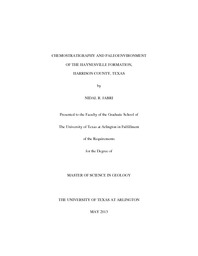
ATTENTION: The works hosted here are being migrated to a new repository that will consolidate resources, improve discoverability, and better show UTA's research impact on the global community. We will update authors as the migration progresses. Please see MavMatrix for more information.
Show simple item record
| dc.contributor.author | Jabri, Nidal R. | en_US |
| dc.date.accessioned | 2013-07-22T20:13:57Z | |
| dc.date.available | 2013-07-22T20:13:57Z | |
| dc.date.issued | 2013-07-22 | |
| dc.date.submitted | January 2013 | en_US |
| dc.identifier.other | DISS-12112 | en_US |
| dc.identifier.uri | http://hdl.handle.net/10106/11826 | |
| dc.description.abstract | The Late Jurassic (Kimmeridgian) Haynesville formation consist of post rift siliciclastics, carbonate, and evaporite deposits that accumulated in continental to deeper marine environments on an asymmetrical basin where topography was modified by salt and basement tectonics. The Haynesville stretches from East Texas to West Louisiana, deposited on the Smackover lime and overlayed by the slightly coarser grained Bossier Formation and the interbedded sands of the Cotton Valley Formation in some places. Complex basin morphology and later stage salt tectonics have played an important role in the development of the sediment fill. The evacuation of salt from overburden increased accommodation space. The basin's architecture had affects on water movement which allowed for a restricted basin and created ideal conditions for anoxic bottom waters. The influx of sediments and nutrients along with anoxic bottom waters conditions contributed to the creation of an organic rich mudstone. However, cyclical changes in water levels, onshore erosional variations, upwellings, and regional environmental factors contributed to the complexity of the entire Haynesville formation. A better understanding of the Haynesville shale on all scales will help in differentiating geological variations and anomalies. This study will focus on micro core analysis but give an overall regional description of Harrison County. Research of geochemical proxies and subsurface analysis of this basin will help in categorizing the basin evolution and sediment fill. The geochemical study will use high definition (HD) bulk chemical analysis obtained from a core scanned at 2 inch intervals. The subsurface analysis will use well logs, top structure maps, initial production maps as a basis for defining hydrocarbon concentrations and migration. The top structure maps will reveal migration pathways and any possible faulting. The geochemical study will be compared to the more conventional well logs to illustrate the lack in resolution. The subsurface database will provide information relating to paleobathymetric deposition and lateral variations related to deeper structural components. Additionally, it will help in understanding sediment and nutrient supply routes. Top Structure maps of the Bossier Formation and Haynesville Formation will be created using Gamma well logs and resistivity logs. Initial production (IP) maps will help in correlating geochemical signatures with hydrocarbon rich strata. Furthermore, bulk chemical elements will be analyzed and compared to provide insight into the depositional environment. The study will focus on the interactions of sediment influx, organic variations, paleotopography, and paleoclimate. The geochemical analysis was used to compare high definition measurements against broader interval measurements. Furthermore, total organic carbon (TOC) and total inorganic carbon (TIC) was analyzed to highlight the sediment sources and organic content. IHS PETRA was used to create the subsurface database. The Costech Element analyzer, UIC Coulometer and ED-XRF was used to create the geochemical analysis. Results from the bulk data have been plotted to show variations in signatures that will help categorize and interpret depositional condition. Overall results indicate that we are working with anoxic bottom waters with a moderate detrital input and periodic oscillating blooms of organics. The detrital input is a result of previous uplift, erosion and transportation from the surrounding environment, both terrestrial and marine. The two major detrital inputs are illite and quartz. The combination of synthesized calcium carbon from the surrounding marine and terrestrial sources; along with the input from in place organics with low oxygen levels provided the building blocks for a source rock. Average TOC values for the base of the Bossier and the Haynesville are 2.51%. Secondly, the average %TIC was 2.09. | en_US |
| dc.description.sponsorship | Rowe, Harry | en_US |
| dc.language.iso | en | en_US |
| dc.publisher | Geology | en_US |
| dc.title | Chemostratigraphy And Paleoenvironment Of The Haynesville Formation, Harrison County, Texas | en_US |
| dc.type | M.S. | en_US |
| dc.contributor.committeeChair | Rowe, Harry | en_US |
| dc.degree.department | Geology | en_US |
| dc.degree.discipline | Geology | en_US |
| dc.degree.grantor | University of Texas at Arlington | en_US |
| dc.degree.level | masters | en_US |
| dc.degree.name | M.S. | en_US |
Files in this item
- Name:
- Jabri_uta_2502M_12112.pdf
- Size:
- 5.575Mb
- Format:
- PDF
This item appears in the following Collection(s)
Show simple item record


